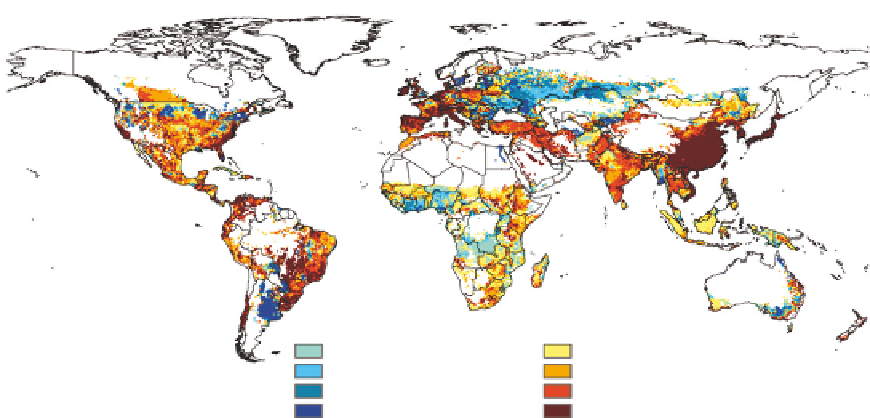Environmental Engineering Reference
In-Depth Information
P surpluses (kg P ha
-1
yr
-1
)
Lowest quartile (0 to 2.5)
Lower-middle quartile (2.5 to 6.2)
Upper-middle quartile (6.2 to 13.0)
Top quartile (13.0 to 840.0)
FIGURE 8.5
Global map of agronomic P imbalances for the year 2000 expressed per unit of cropland area in
each 0.5
grid cell. Inputs to each cell are fertilizers and manures applied. Outputs are crops harvested. The differ-
ence between inputs and outputs is the change-in-storage. The P surpluses and deficits shown here are each clas-
sified according to quartiles globally (0
P deficits (kg P ha
-1
yr
-1
)
Lowest quartile (0 to -0.8)
Lower-middle quartile (-0.8 to -1.9)
Upper-middle quartile (-1.9 to -3.2)
Top quartile (-3.2 to -39.0)
25th, 25
50th, 50
75th, and 75
100th percentiles). (Reprinted from
MacDonald et al. 2011
.)
global P deficit. Similarly, 10% of the cropland area with the largest surpluses contributes
45% of the cumulative global P surplus.
Agricultural areas with surplus P often face issues of runoff due to loss of P with
eroded soil or dissolved in water runoff. Dissolved P in soil solution travels in ground
water to running waters and standing waters. Particulate forms of P are transferred by
stream-bank erosion and overland flow of water. Particulate P transfer in erosion is
usually thought to encompass the vast majority of P runoff in agricultural areas.
Ultimately, this P ends up in the oceans. The net input of dissolved P to the oceans is
4
6 Tg P/year (
Filippelli 2008
), a doubling of prehuman inputs. Estimates of particulate P
inputs range from 6 Tg P/year (
Seitzinger et al. 2010
) to 20 Tg P/year (
Meybeck 1982
).
Reconstructions of human-caused P inputs from land to the oceans, and projections into
the future indicate that sustained and significant eutrophication can be expected over the
next two millennia (
Figure 8.6
). This figure shows the reconstructions and projections of
anthropogenic P delivery to the oceans as a result of fertilization, deforestation, and soil
loss. The fertilizer drop-off in about 2100 coincides with estimates of the date of expected
depletion of known reserves.
Cities are playing an increasingly important role in the global P cycle. The food require-
ments of urban areas are supplied from agricultural areas that may be thousands of
kilometers away. The import of food is generally the primary P input to urban areas
although P in cleaning products can also be significant. Both these P imports generally
end up in sewage treatment plants. In the 1960s, essentially all the P in sewage was
pumped into rivers, lakes, and estuaries. Today the extent of P removal in these plants
varies dramatically. Some sewage treatment plants still remove little to no P. Even those


